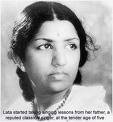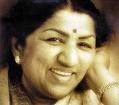1940s
Mangeshkar's first cinematic song was for the Marathi film Kiti Hasaal (1942), produced by Vasant Joglekar. However, her father disliked the idea of any of his daughters singing for movies, so the song was dropped from the film.
In 1942, Mangeshkar's father died of heart disease. Due to the death of her father and the resultant financial distress, Lata played cameo roles in many Hindi and Marathi films, despite not personally enjoying acting.
In 1945, Ghulam Haider took her to meet producer S. Mukherji, who was working on a movie starring Kamini Kaushal. Haider wanted the 16-year-old Mangeshkar to get a chance to sing, but the producer dismissed her voice. Annoyed, Haider said, "Let me foretell today that this girl will soon put to shame everyone else, including Noor Jehan. Producers and directors will fall at her feet, begging her to sing in their films."[6]
Mangeshkar's big break came with the 1949 song "Aayega Aanewaala" from the movie Mahal for Madhubala and was composed by Khemchand Prakash. Mahal was a hit, a turning point for both Madhubala and Mangeshkar.[6]
1950s
The 1950s saw Mangeshkar soar to the top of the heap of Bollywood singers. She recorded songs for all the major composers of the period, including Shankar Jaikishan, Naushad, S D Burman, C. Ramchandra, Hemant Kumar, and Salil Chowdhury.
Shankar Jaikishan used Lata as their female singer in all the movies they scored, mainly for Raj Kapoor. These movies include Aag, Aah (1953), Shree 420 (1955), and Chori Chori (1956). Some famous Lata tunes from these movies include "Mera Ang Ang Muskaya" (from Aah), "Ichak Dana Bichak Dana" (from Shree 420), and "Panchhi Banoon Udti Phiroon" (from Chori Chori).ui
Lata also became the main female singer for Naushad during the 1950s, beginning with Baiju Bawra (1952). Naushad's tunes were all classical raga-based compositions, and Mangeshkar turned out hits such as "Mohe Bhool Gaye Sanwariya" and "Bachpan Ki Mohabbat Ko" for Baiju Bawra.
S.D. Burman used Lata as his female singer for hit songs such as "Tum Na Jaane Kis Jahan Mein Kho Gaye" from Sazaa (1951), "Phaili Hui Hai Sapnon Ki Baahen" from House No. 44 (1955), and "Ab Aage Teri Marzi" from Devdas (1955). In 1957, however, Mangeshkar and Burman had a major falling-out, and Lata refused to record for him again until 1962. During this time, Burman groomed Asha Bhosle, Lata's younger sister, as his main female voice, and also utilized Geeta Dutt as well.
It was also during the 1950s that Lata formed her association with one of her absolute favourite composers, Salil Chowdhury. In 1953, Mangeshkar recorded "Aa Ri Aa Nindiya" from Do Bigha Zameen for "Salilda." 1958 saw the release of the Bimal Roy-directed blockbuster Madhumati, starring Dilip Kumar and Vyjayantimala. Chowdhury provided the music for the film, and "Aaja Re Pardesi" stands as one of Lata's most famous songs. It netted her her first Filmfare Award for Best Female Playback Singer.
1960s
The 1950s saw Mangeshkar make her case to enter the upper echelons of Bollywood music. However, it was the 1960s that saw Lata become the undisputed queen of Bollywood playback singing. She recorded songs for nearly every major composer in the industry, many of which became all-time hits.
1960 saw Lata render numerous hits for various music directors. She teamed up with Naushad to produce "Pyar Kiya To Darna Kya" for the lavish Mughal-era romance Mughal-E-Azam, perhaps the most popular song from that film. She also recorded several duets with Mohammad Rafi under Naushad's baton for Kohinoor, including the timeless "Do Sitaron Ka Zameen Par." For Shankar Jaikishan, she rendered the Hawaiian-themed number "Ajeeb Dastaan Hai Yeh" from Dil Apna Aur Preet Parai, picturized on Bollywood's tragedy queen, Meena Kumari. Finally, her partnership with Salil Chowdhury continued to bear fruit in the classical-tinged "O Sajana Barkha Bahaar" from Parakh.
In 1961, Mangeshkar took the first step on the road to reconciliation with S D Burman, as she recorded a bhajan, "Allah Tero Naam," for Burman's assistant, Jaidev. One of Lata's finest devotional pieces, it is said to have awakened eminent classical vocalist Pandit Jasraj from his sleep, with tears streaming down his cheeks.
1962 saw Lata record perhaps her most famous song, a patriotic song- "Ae Mere Watan Ke Logon" that was composed by C. Ramchandra and had its lyrics written by Pradeep. A moving tribute to Indian soldiers who fell in the Sino-Indian War, the song is said to have moved the then Prime Minister, Jawaharlal Nehru, to tears when sang at the Indian Parliament. That year, she bagged her second Filmfare Award for Best Female Playback Singer for the haunting "Kahin Deep Jale, Kahin Dil" from the movie Bees Saal Baad, composed by Hemant Kumar.
In 1963, Mangeshkar returned to collaboration with S.D. Burman, mainly as a result of a truce brokered by Burman's son, budding Bollywood composer (and future brother-in-law) R.D. Burman. The sugary sweet "Mora Gora Ang Lai Le" picturized on Nutan was a huge hit from the movie Bandini, directed by Bimal Roy. In 1965, she produced some more hits under Burman's direction for Guide, including "Aaj Phir Jeene Ki Tamanna Hai" and "Gaata Rahe Mera Dil" (the latter a duet with Kishore Kumar).
Along with Salil Chowdhury, Madan Mohan was another of Mangeshkar's favourite composers. Madan Mohan created the ghazal "Aap Ki Nazron Ne Samjha" from Anpadh in 1962; the pair would produce many other memorable songs over the years. 1964 in particular saw the release of Raj Khosla's Woh Kaun Thi?, which featured music by Madan Mohan. Two romantic songs from this movie, the haunting "Naina Barse Rim Jhim" and the emotional "Lag Ja Gale," both proved to be enormous hits. Two years later, Madan Mohan again utilized Mangeshkar for Khosla's Mera Saaya; the song "Tu Jahan Jahan Chalega" from this movie was another smash hit. To this day songs from Woh Kaun Thi? and Mera Saaya are an essential component of Mangeshkar's repertoire for live shows.
The 1960s also witnessed the beginning of Mangeshkar's relationship with Laxmikant-Pyarelal, the duo for which she would sing the most songs in her career. She recorded for them in their first Bollywood film, Parasmani, in 1963, and continued to work with them in films such as Dosti (1964), Farz (1967), and Milan (1967), continuing on into the 1970s.
1970s
Mangeshkar performed tracks for star Meena Kumari, again, this time in the film Pakeezah (1971), with music by Ghulam Mohammed.
S.D. Burman's final films were in the 1970s, before falling into a coma and dying in 1975. Lata performed in the films Prem Pujari, Sharmilee (1971), and Abhimaan (1973). In Abhimaan she performed vocals at the age of 44, for 25-year-old actress Jaya Bachchan.
Teaming up once more with Salil Chowdhury she performed in the film Annadata (1971) and the title song of Chhoti Si Baat (1974). She also released an album of Meera bhajans composed by her brother. The album was titled "Chala Vaahi Des". Some of the bhajans in the album include "saanware rang raachi" and "ud jaa re kaaga".
Continuing their relationship from the 60's into the 70's, Lata and Laxmi-Pyare were together again (with Rahul Dev Burman in the mix). Writers Anand Bakshi and Majrooh Sultanpuri wrote most of the tracks, penning songs for the films Amar Prem (1971), Caravan (1971), and Raj Kapoor's Satyam Shivam Sundaram (1978). Mangeshkar and Kishore Kumar performed songs for R D Burman and lyricist Gulzar in the film Aandhi in 1975. R D Burman also effectively tapped the melody in Lata's throat in the songs of the wonderful film Kinara, famous for "Naam gum jaayega" and "abke na saawan barse".
Mangeshkar performed in 1976 for composer Khayyam and songwriter Sahi Ludhiyanvi for the film Kabhi Kabhie, and again with Khayyam in Shankar Hussain in 1977 and "Chambal ki Kasam" in 1979. She also sang for Naushad in "Chambal ki Raani".
1980s
In late 1970s and early 1980s, Lata worked with the children of composers she had earlier worked with. Apart from Sachin and Rahul Dev Burman, Lata worked has worked with Chitragupta and his sons Anand-Milind, Roshan and his son Rajesh Roshan, and Sardar Malik and his son Anu Malik. Rajesh Roshan's first film Julie had some numbers sung by Lata, including Bhool gaya sab kuchh (duet with Kishore Kumar) and Yeh Raatein Nai Puraani.
Lata also sang in Raj Kapoor`s Ram Teri Ganga Maili, singing songs composed by the blind composer Ravindra Jain.
Apart from that, Mangeshkar has sung in many Rajshri Production movies, including the hit Maine Pyar Kiya.
1990s
In 1990, Mangeshkar launched her own production house. Its first (and only movie), Lekin, flopped.[6] Mangeshkar also recorded many non-film songs, including ghazals with Jagjit Singh.[6]
Mangeshkar also sang for all of Yash Chopra`s films, including Lamhe, Darr, Yeh Dillagi, Dilwale Dulhaniya Le Jayenge, Dil To Pagal Hai and Veer-Zaara.
A. R. Rahman has recorded a number of songs with Mangeshkar, including "Jiya Jale" (from Dil Se, danced by Preity Zinta), "Khamoshiyan Gungunane Lagin" (One Two ka Four), and "O Paalanhaare" (Lagaan).
She has also sung for different successful films like 1942: A Love Story, Karan Arjun, Dushman and Jab Pyaar Kisise Hota Hai.
2000s
She continues to sing in Yash Chopra films such as Mujhse Dosti Karoge! and Veer Zaara.
She has also sung a few songs for movies like Zubeidaa, Lagaan, Page 3, Mohabbatein, Kabhi Khushi Kabhie Gham, Bewafaa, Lucky: No Time for Love and Rang De Basanti.
Lata's song "Wada na Tod" is also heard playing in the background of the film "Eternal Sunshine of the Spotless Mind" and can be found on th film's soundtrack.
Lata Mangeshkar's latest album Saadgi released on June 21st 2007. It has eight ghazals with music by Mayuresh Pai








